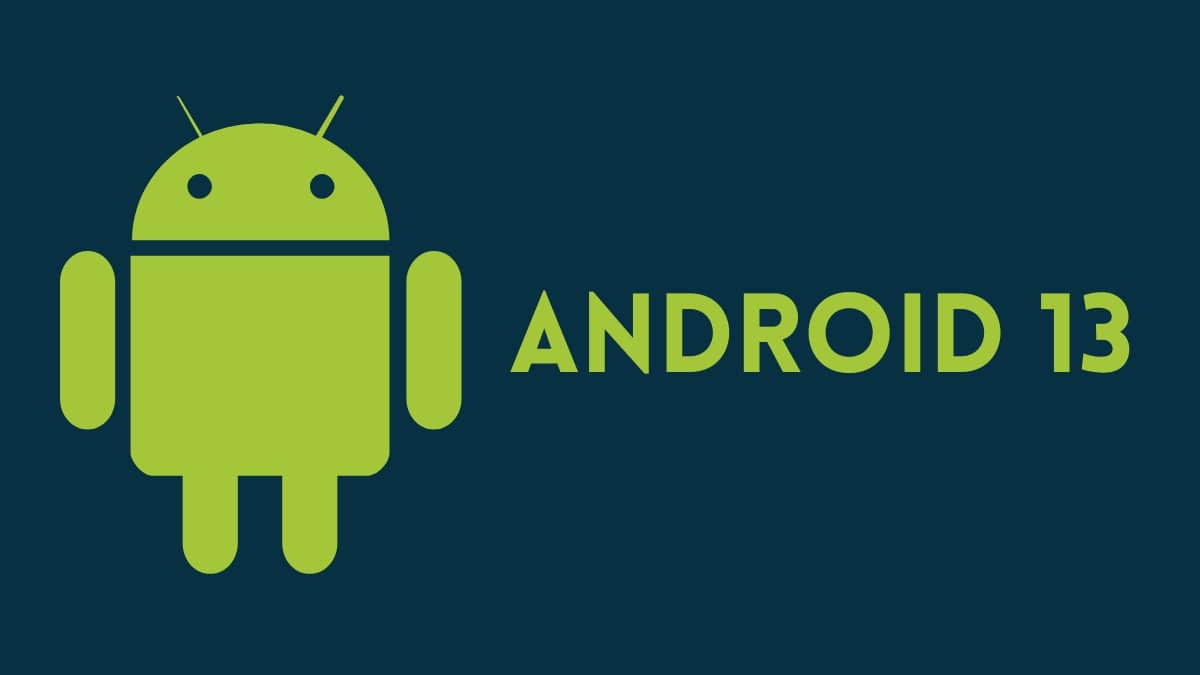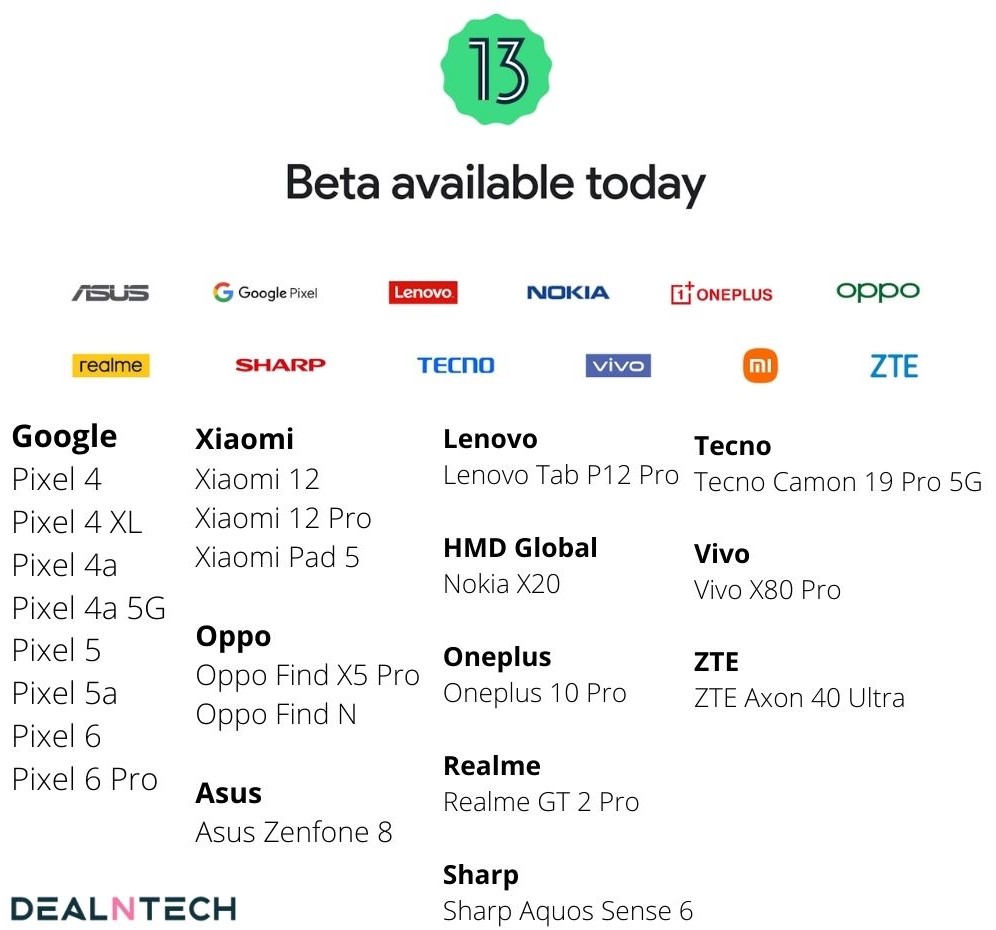Google announced its Android 12 OS at the Google I/O event. The new Android 12 OS brings significant security and privacy improvements compared to Android 11 with an all-new Material You design. Pixel devices and some high-end smartphones from brands like Xiaomi and Realme have already started grabbing the Stable update of Android 12 in their system. Now, Google has officially unveiled Android 13. Here, we will discuss everything we know about the upcoming Android 13 OS. We have plenty of information about Android 13 to share.
What is Android 13?
Android 13 is the thirteen major versions of the Android operating system. It is the successor to Android 12. Android 13 carries the codename Tiramisu. The codenames of Android versions are based on the names of different sweets. Following the same, the Android 13, which has the codename Tiramisu, is a coffee-flavored dessert.
Android 13 features include More Material You theming options, Enhanced notifications, Tap-to-transfer, Resolution switching, Auto-theming icons, Cinematic wallpapers, Turn on dark mode at bedtime, Screen saver revamp, Per-app language preferences, System Photo Picker, App drawer in the taskbar, Clipboard editor overlay, Vibration sliders for alarm and media, and more.
Android 13 Update Tracker
| Xiaomi Android 13 | Check Status |
| Realme Android 13 | Check Status |
| Poco Android 13 | Check Status |
| Samsung Android 13 | Check Status |
| Vivo Android 13 | Check Status |
| Oppo Android 13 | Check Status |
| iQOO Android 13 | Check Status |
| Motorola Android 13 | Check Status |
| OnePlus Android 13 | Check Status |
| Asus Android 13 | Check Status |
November 22: The Android 13 stable version is now available on Galaxy Tab S8 family, M32 5G, M52 5G, S20 FE, S21 FE, A71, F62, Note 10 Lite, Z Fold 3, Z Flip 3, and Tab S7 family.
November 16: Asus has shared the Android 13 rollout plan. The Zenfone 9 will receive the update in December 2022.
November 15: OnePlus 8, 8 Pro, 8T, 10R, 9R, and 9RT users can experience the stable Android 13 (OxygenOS 13)version.
November 11: Samsung has released the stable One UI 5 update for Galaxy Z Flip 4, Z Fold 4, A73, A33, Galaxy A53, Note 20 series, S20 Series, S21 series, and S22 series in select countries. The update will be available in more countries soon.
November 10: Android 13 stable update is rolling out for the OnePlus 9 and 9 Pro in North America, Europe, and India.
November 8: Xiaomi 12 Pro has received the Android 13 stable version via a software update in China.
October 21: Realme is seeding a stable Android 13 update for its Realme GT 2 Pro handset in India.
October 25: Stable Android 13 build-based One UI 5 skin is now available for Galaxy S22 Series. The update is rolling out in Europe, Asia, and the US (Verizon Only). The Android 13 Beta program is also live for the Galaxy Z Flip and Z Flip 5G in South Korea.
October 21: Samsung Galaxy Z Fold 3, Z Flip 3, Z Fold 4, Z Flip 4, Z Fold 2, Note 20 series, Galaxy A52, Galaxy S20 Series, Galaxy S21 Series, and Galaxy S22 Series users can experience One UI 5 Beta by joining the beta program.
October 19: Google has announced Android 13 (Go Edition) for low-end phones. The Go Edition mainly gives preference to reliability, usability, and customization. The Google Discover feed now arrives on Go edition devices. You can also access Material You, first introduced with Android 12. The Go edition also brings notification permissions and app language preferences. Android 13 (Go edition) devices will arrive in 2023.
October 16: The OxygenOS 13 Open Beta program is available for the OnePlus 9RT, 10R, 9 Series, 8 Series, and 8T.
September 21: OnePlus 10 Pro owners are receiving Android 13 (OxygenOS 13) Stable build in India, Europe, and North America with firmware version C.19.
September 19: Realme has shared its Android 13 rollout plan for global users. You can check the roadmap here.
August 27: Asus has announced the Android 13 beta program for its Zenfone 9 handset. Interested users can apply for the program by clicking “Enroll in the Beta Test Program” on the device’s settings page.
August 24: Nothing CEO Carl Pei reveals that the Nothing Phone 1 will get Android 13 beta by the end of 2022.
August 20: The initial batch of Motorola phones eligible for the Android 13 update includes Edge+ (2022), Edge (2022), Edge 30 Pro, Edge 30, G82 5G, G62 5G, G42, G32, G Stylus 5G 2022, and G 5G 2022.
August 20: OPPO announced its latest Android 13-based skin, ColorOS 13. The ColorOS 13 rollout has reportedly begun in batches globally, starting with the Oppo Find X5 Find X5 Pro models. Oppo plans to update 35 handsets across 60 countries globally in 2022.
August 19: OnePlus has announced the Android 13-based OxygenOS 13 Closed Beta Testers recruitment program in India. You can apply for the program using Indian OnePlus 8T, OnePlus 9R, and OnePlus 10R units. Only 200 people for each device will be eligible for this Closed Beta Program.
August 15: Android 13 Stable Build is finally out. This year, the final version gets an official release a little earlier than usual. The build is now available for Google Pixel smartphones. Google says Android 13 will also roll out later this year to other devices from OnePlus, Samsung Galaxy, Oppo, Vivo, Asus, Nokia, Motorola, iQOO, Realme, Sony, Tecno, Xiaomi and more.
August 9: OnePlus 10 Pro models in India and North America have received Android 13-based OxygenOS 13 Open Beta 1 (OBT1) with build C.16. European OnePlus 10 Pro units will also get the Open Beta 1 update shortly.
August 8: The Android 13 beta for select Samsung phones is now live. Android 13 beta is currently available on the Galaxy S22 series (Galaxy S22, Galaxy S22+ and Galaxy S22 Ultra) in the United States, Germany and South Korea.
July 25: Beta 4.1 (TPB4.220624.008) is a minor update that fixes issues with the main beta launch. The fixes include enabling or disabling Bluetooth, device rebooting when connecting to WiFi networks, incorrectly interpreting GPS data, and more.
July 13: Android 13 Beta 4 arrives as the final Beta build. The latest Beta 4 is a release candidate built for final testing. That means the official release of Android 13 is just a few weeks away.
June 27: Google rolls out the Android 13 Beta version 3.3 with stability improvements, bug fixes, and better performance. The build number is TPB3.220617.002. The latest build also increases the Google Play services version from 22.18.19 to 22.21.16.
June 20: Android 13 DP 2 (Developer Preview Verison 2) is available for Oppo Find X5 Pro (Global/China), Realme GT 2 Pro (China), Vivo X80 (China), Vivo X80 Pro (China), OnePlus 10 Pro (China/ North America/ India/ Europe), and Nokia X20.
June 16: Android 13 Beta 3.2 arrives with several bug fixes, which include back gesture issues, app crashes, settings page collapse, microphone turning on/off unexpectedly, and more. The beta 3.2 build is available for Pixel devices.
June 8: Android 13 OS has reached the Platform Stability milestone with the Beta 3 release. It means all app-facing behaviors and APIs are now final.
May 12: Google has announced Android 13 officially at Google I/O. Currently, the second Beta of Android 13 is available for select devices. The Beta is open for 22 devices from 12 OEMs. To join the beta program, you must visit OEM’s dedicated Android page, sign in, and enroll your device. An OTA update notification should soon arrive on your device, prompting you to download the Android 13 beta build.
May 6: Android 13 Beta 1 for Android TV is available for developers. Reportedly, Android 13 could block sideloaded apps from using accessibility features.
April 28: Google I/O 2022, the company’s annual developer conference, is scheduled for May 11 and 12. The company will likely introduce Android 13 alongside the Pixel 6a and Pixel Watch.
April 26: The first public Beta of Android 13 is now available. Android 13 Beta 1 system images are available for the Pixel 4a, Pixel 4a 5G, Pixel 4 (XL), Pixel 5, Pixel 5a, Pixel 6, and Pixel 6 Pro. You can get Android 13 on a supported Google Pixel device by enrolling in the Android Beta for Pixel program. The most highlighted features of Android 13 beta 1 include more granular access to media files, improved error reporting, and Anticipatory audio routing.
February 10: The first Android 13 Developer Preview has been released. In addition, Google has also shared a rough timeline for the Android 13 rollout. Judging from that information, we expect the Android 13 stable version to be out in early September 2022.
December 24: As per Mishaal Rahman, Android 13 will add full support for Bluetooth LE Audio. Xda-Developers has also shared some of the expected features of Android 13 that include Runtime Permission for Notifications, Individual App Languages Support, New Lock Screen Clock Layouts, and TARE: The Android Resource Economy.
December 14: Reportedly (via Mishaal Rahman), Google may allow users to toggle on/off the Phantom Process Killer in Android 13. Users have to navigate to this path: Settings > Developer Settings > Feature flags
September 25: Xda-Developers spotted changes in the Android Open Source Project (AOSP) code. It reveals that Google may include DNS over HTTPS support in Android 13.
August 26: Google’s Pixel 6 smartphone will have ultra-wideband (UWB) support as the company is reportedly working on expanding UWB support in Android 13.
July 27: Google has reportedly decided on the dessert name of Android 13, which will be internally called Tiramisu.
When will Android 13 be released?
The Android 13, the next version of Android 12 OS, was announced on April 26. Currently, Google is rolling out the Android 13 Stable build for Pixel phones only. The stable version was released on August 15, 2022.
| Android 13 Builds | Release Timeline |
|---|---|
| Developer Preview 1 | February 10, 2022 |
| Developer Preview 2 | March 17, 2022 |
| Beta 1 | April 26, 2022 |
| Beta 2 and 3 | May-June 2022 |
| Beta 4 | July 13, 2022 |
| Stable Build | August 15, 2022 |
Which phones will get Android 13?
The Google Pixel 6 Pro, Pixel 6, Pixel 5a 5G, Pixel 4, Pixel 4a 5G, Pixel 4XL, Pixel 5 and Pixel 5XL will get the guaranteed support of Android 13, all thanks to long-term software support by Google.
We all know that LG has closed its smartphone business, but the company previously confirmed that their selected devices would get Android 13. The list includes various devices like LG G8X ThinQ, LG Wing, LG G8S ThinQ, LG V50S ThinQ 5G, etc.
Following the software update policy of Samsung and Vivo, it’s pretty clear that some of their selected devices will get Android 13 OS. The Samsung Android 13 supported phones list will include Galaxy S22, S22+, S22 Ultra, S21, S21+, S21 Ultra, Z Flip 3, and Z Fold 3. Vivo’s X70, X70 Pro, and X70 Po+ will be included in the Android 13 list.
Android 13 Eligible Devices List (Confirmed So Far)
- Pixel 4
- Pixel 4 XL
- Pixel 6
- Pixel 6 Pro
- Pixel 4a
- Pixel 4a 5G
- Pixel 5
- Pixel 5a
Xiaomi
- Xiaomi 12 Pro
- Xiaomi 12
- Xiaomi Pad 5
Oppo
- Oppo Find N
- Oppo Find X5 Pro
Asus
- Asus Zenfone 8
Lenovo
- Lenovo Tab P12 Pro
Nokia
- Nokia X20
Oneplus
- OnePlus Nord CE, CE 2, CE 2 Lite
- OnePlus 8, 8 Pro, 8T
- OnePlus 10 Pro
- OnePlus 9R, 9RT
- OnePlus 9, 9 Pro
- OnePlus 10R
- OnePlus 10T
- OnePlus Nord 2
- OnePlus Nord 2T
Realme
- Realme GT 2 Pro
Vivo
- Vivo X80 Pro
ZTE
- ZTE Axon 40 Ultra
Sharp
- Sharp Aquos Sense 6
Tecno
- Tecno Camon 19 Pro 5G
Samsung
- Galaxy S22 Series
Motorola
- Moto G Stylus 5G 2022
- Moto G 5G 2022
- Motorola Edge+ (2022)
- Motorola Edge (2022)
- Motorola Edge 30 Pro
- Motorola Edge 30
- Moto G82 5G
- Moto G62 5G
- Moto G42
- Moto G32
7 Best Android 13 Features:
1. New Material You Color Options
Android 12 brought the concept of Material You to the table. It is a wallpaper-based theming system that lets you match the user interface with your wallpaper. However, there were certain limitations to this feature. You could only choose from 4 wallpaper colors and four primary colors.
Choosing your favorite colors for Material You was not an option. With Android 13, it still isn’t, but you can now choose from a total of 16 color options. There is a high chance you might find your favorite color.
2. Edit Text Directly From the Clipboard
This one is my personal favorite. We often copy something to our clipboard but need to make some changes. With Android 12, you had to paste the text from the clipboard, edit it, and then copy it to the clipboard. Not anymore; with Android 13, you can now edit the copied text on your clipboard using the pencil icon on the bottom.
3. Easy Access to QR Code Scanning
Scanning QR codes for digital payments or other purposes has become a vital part of our lives. With Android 13, scanning a QR code is more effortless to access things. You will be able to scan any QR code right from your lock screen. The QR code scanner has also been integrated into the Quick Settings menu for easy access.
4. Panlingual App-Specific Languages
Google has finally added the feature to set app-specific languages rather than just setting a system language. A code named panlingual allows you to set different languages for different apps. This feature can be useful when using apps that do not support multiple languages.
5. Control your Smart Home Devices from the Lock Screen
Having to unlock your phone each time to control your devices could be tiring for some people. That’s why Google has introduced a new feature to Android 13 where users can easily control their smart home devices right from the lock screen. For some reason, the feature is turned off by default. You need to turn it on manually.
6. 3D Cinematic Wallpapers and Wallpaper Dimming
Google is introducing 3D wallpapers to Android 13 that move as you move your phone. This feature allows you to give a 3D effect to any wallpaper. This feature is not yet live, but we will see it in Android 13 soon. Additionally, there is another feature within the wallpaper section called Dimming Wallpaper. This feature dims your current wallpaper, making it less bright for a better view in the dark.
7. Tap to Switch between Audio Devices
With Android 13, Google is finally adding the feature to switch between devices with just a tap. This will make switching between devices, especially audio devices, much more convenient. This feature has been in Android skins for a long time and is finally making it to stock Android.





Don
You forgot nothing Phone 1
limhoonghong
i am using Infinix Note 10.this phone is Android 11.will Google provide Android 12 update for this phone and when ? i live in Malaysia.